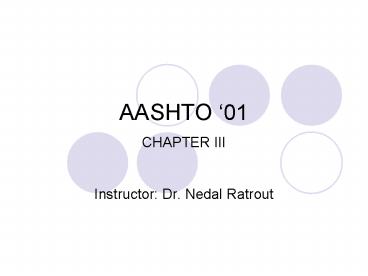AASHTO 01 - PowerPoint PPT Presentation
1 / 15
Title:
AASHTO 01
Description:
... for Turks and passenger cars, therefore, are not generally used ... to-perceive information source or condition in a roadway environment that may be ... – PowerPoint PPT presentation
Number of Views:12
Avg rating:3.0/5.0
Title: AASHTO 01
1
AASHTO 01
- CHAPTER III
- Instructor Dr. Nedal Ratrout
2
Elements of Design
- Sight Distance
- Four aspects of sight distance are discussed
below - The sight distance needed for stopping.
- The sight distance needed for the passing of
overtaken vehicles. - The sight distances needed for decisions at
complex locations - The criteria for measuring these sight distance
for use in design.
3
Stopping Sight Distance
- Sight distance is the length of the roadway ahead
that is visible to the driver. The available
sight distance on a roadway should be
sufficiently long to enable a vehicle traveling
at or near the design speed to stop before
reaching a stationary object in the path. - Stopping sight distance is the sum of two
distances - The distance traversed by the vehicle form the
instant the driver sights an object necessitating
a stop to the instant the brake are applied - The distance needed to stop the vehicle form the
instant brakes application begins. These are
referred to as brake reaction distance and
braking distance, respectively.
4
Brake Reaction Time
- The study of reaction time by Johansson and Rumar
- Referred to the median reaction-time value for
these drivers was 0.66 s. with 10 percent using
1-5 s or longer. - Another study, found 0.64 s as the average
reaction time, while 5 percent of the drivers
needed over 1 s. - In a third study, the values of brake reaction
time ranged form 0.4 to 1.7 s - The recommended design criterion of 2.5 s for
brake reaction time exceeds the 90th percentile
of reaction time for all drives and has been used
in the development of Exhibit 3-1
5
Braking Distance
6
Design Values
- The sum of the distance traversed during the
brake reaction time and the distance to brake the
vehicle to a stop is the stopping sight distance.
- In computing and measuring stopping sight
distances, the height of the drivers is 600
mm2.0 ft, equivalent to the taillight height of
a passenger car.
7
Effect of Grade on Stopping
- The stopping distances needed on upgrade are
shorter than on level roadway those on
downgrades are longer. The stopping sight
distances for various grades are shown in Exhibit
3-2.
8
(No Transcript)
9
Variation for Trucks
- Trucks as a whole, especially the larger and
heavier units, need longer stopping distances
form a given speed than passenger vehicles.
However, the truck driver is able to see
substantially farther beyond vertical sight
obstructions. - Separate stopping sight distances for Turks and
passenger cars, therefore, are not generally used
in highway design.
10
Decision Sight Distance
- Decisions sight distance is the distance needed
for a driver to detect an unexpected or otherwise
difficult-to-perceive information source or
condition in a roadway environment that may be
visually cluttered. - Because decision sight distance offers drivers
additional margin for error and affords them
sufficient length to maneuver their vehicles at
the same or reduced speed, rather than to just
stop, its values are substantially greater than
stopping sight distance. - Drivers need decision sight distances whenever
there is a likelihood for error in either
information reception, decision-making, or
control actions.
11
Passing Sight Distance for Two-Lane Highways
- Passing sight distance for use in design should
be determined on the basis of the length needed
to be complete normal. - Sight distance should be determined for a single
vehicle passing a single vehicle.
12
Passing Sight Distance for two-Lane Highways
- The minimum passing sight distance for two-lane
highways is determined as the sum of the
following four distances ( shown in Exhibit 3-4) - Distance traversed during perception and reaction
time and during the initial acceleration to the
point of encroachment on the left lane. - Distance traveled while the passing vehicle
occupies the left lane. - Distance between the passing vehicle at the end
of its maneuver and the opposing vehicle. - Distance traversed by an opposing vehicle for
two-thirds of the time the passing vehicle
occupies the left lane, or 2/3 of d2 above. - In Exhibit 3-5. Time and distance values were
determined in relation to the average speed of
the passing vehicle.
13
(No Transcript)
14
(No Transcript)
15
- THANK YOU































